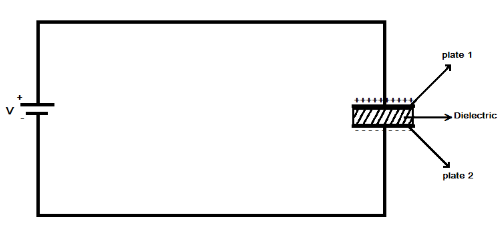
What is the working principle of a capacitor ?
Answer
507.6k+ views
Hint: First we have to understand meaning and the work done by the capacitor in an electrical circuit. Capacitor is the component used for the changing or storage of the electric charge in the circuit. This can be later used as the electric current if the power is interrupted. The basis of this work depends on some principle that we have to discuss.
Complete answer:
Capacitor: It is a device which stores charge in the electrical circuit. A capacitor works on the principle that the capacitance of a conductor shows increase when an earthed conductor is brought near it. Therefore, the capacitor has two parallel plates facing each other in opposite directions and are separated by some distance or gap. This gap is filled with vacuum or the dielectric material with some constant as per the requirement.
Working principle of capacitor: let us consider a parallel plate capacitor with a dielectric between them as shown in the below circuit. Now, apply the voltage V as shown in the circuit, plate 1 has the positive charge and plate 2 has negative charge. Across the capacitor an electric field appears. When these plates are applied with the voltage they will carry positive charge from the battery at plate 1 and negative charge on plate 2. For some time the voltage is applied and within that time the capacitor gets charged to the maximum limit of holding charge and this time is called as charging time of the capacitor.

After some time when the capacitor has reached its maximum limit of charging then we will cut the supply of power to the capacitor. For a certain time, the two plates hold a negative and positive charge. Thus, the capacitor acts as a source or electric charge. If these plates are connected to a load, the current flows through the load from plate 1 to plate 2 until all the charges are dissipated from both plates. This time of discharging of the capacitor is known as the time of dissipation.
Note:Capacitor is also known as the charging device in the electrical circuit which can be used even after the power is cut off in the circuit. We use capacitors in the electrical devices so that we can perform our remaining work in that particular dissipation or discharging time, like saving data on the computer, etc.
Complete answer:
Capacitor: It is a device which stores charge in the electrical circuit. A capacitor works on the principle that the capacitance of a conductor shows increase when an earthed conductor is brought near it. Therefore, the capacitor has two parallel plates facing each other in opposite directions and are separated by some distance or gap. This gap is filled with vacuum or the dielectric material with some constant as per the requirement.
Working principle of capacitor: let us consider a parallel plate capacitor with a dielectric between them as shown in the below circuit. Now, apply the voltage V as shown in the circuit, plate 1 has the positive charge and plate 2 has negative charge. Across the capacitor an electric field appears. When these plates are applied with the voltage they will carry positive charge from the battery at plate 1 and negative charge on plate 2. For some time the voltage is applied and within that time the capacitor gets charged to the maximum limit of holding charge and this time is called as charging time of the capacitor.

After some time when the capacitor has reached its maximum limit of charging then we will cut the supply of power to the capacitor. For a certain time, the two plates hold a negative and positive charge. Thus, the capacitor acts as a source or electric charge. If these plates are connected to a load, the current flows through the load from plate 1 to plate 2 until all the charges are dissipated from both plates. This time of discharging of the capacitor is known as the time of dissipation.
Note:Capacitor is also known as the charging device in the electrical circuit which can be used even after the power is cut off in the circuit. We use capacitors in the electrical devices so that we can perform our remaining work in that particular dissipation or discharging time, like saving data on the computer, etc.
Recently Updated Pages
Master Class 12 Business Studies: Engaging Questions & Answers for Success

Master Class 12 Economics: Engaging Questions & Answers for Success

Master Class 12 English: Engaging Questions & Answers for Success

Master Class 12 Maths: Engaging Questions & Answers for Success

Master Class 12 Social Science: Engaging Questions & Answers for Success

Master Class 12 Chemistry: Engaging Questions & Answers for Success

Trending doubts
What are the major means of transport Explain each class 12 social science CBSE

Which are the Top 10 Largest Countries of the World?

Draw a labelled sketch of the human eye class 12 physics CBSE

How much time does it take to bleed after eating p class 12 biology CBSE

Explain sex determination in humans with line diag class 12 biology CBSE

Differentiate between homogeneous and heterogeneous class 12 chemistry CBSE




